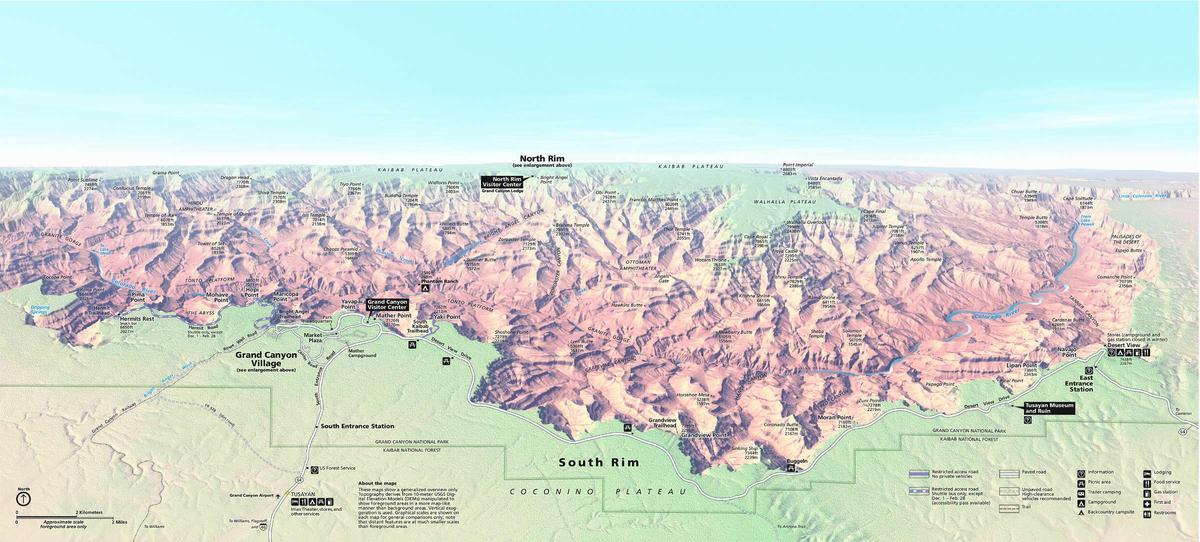Grand Canyon NP--South Kaibab Trailhead
Grand Canyon NP--South Kaibab Trailhead
South Kaibab Trail Grand Canyon Village, Arizona 86023
Official WebsiteDay Hiking - Grand Canyon National Park
Grand Canyon National Park website
Grand Canyon National Park maps
Tips for Birding
In-depth information is found on the Grand Canyon National Park website.
About this Location
Hikers seeking panoramic views unparalleled on any other trail at Grand Canyon will want to consider a hike down the South Kaibab Trail. It is the only trail at Grand Canyon National Park that so dramatically holds true to a ridgeline descent. But this exhilarating sense of exposure to the vastness of the canyon comes at a cost: there is little shade and no water for the length of this trail. During winter months, the constant sun exposure is likely to keep most of the trail relatively free of ice and snow. For those who insist on hiking during summer months, which is not recommended in general, this trail is the quickest way to the bottom (it has been described as “a trail in a hurry to get to the river”), but due to lack of any water sources, ascending the trail can be a dangerous proposition.
The South Kaibab Trail is a modern route, having been constructed as a means by which park visitors could bypass Ralph Cameron’s Bright Angel Trail. Cameron, who owned the Bright Angel Trail and charged a toll to those using it, fought dozens of legal battles over several decades to maintain his personal business rights. These legal battles inspired the Santa Fe Railroad to build its own alternative trail, the Hermit Trail, beginning in 1911 before the National Park Service went on to build the South Kaibab Trail beginning in 1924. In this way, Cameron inadvertently contributed much to the greater network of trails currently available for use by canyon visitors.
About Grand Canyon National Park
See all hotspots at Grand Canyon National Park
Grand Canyon is considered one of the finest examples of arid-land erosion in the world. Incised by the Colorado River, the canyon is immense, averaging 4,000 feet deep for its entire 277 miles. It is 6,000 feet deep at its deepest point and 18 miles at its widest. However, the significance of Grand Canyon is not limited to its geology.
The Park contains several major ecosystems. Its great biological diversity can be attributed to the presence of five of the seven life zones and three of the four desert types in North America.
The five life zones represented are the Lower Sonoran, Upper Sonoran, Transition, Canadian, and Hudsonian. This is equivalent to traveling from Mexico to Canada.
The Park also serves as an ecological refuge, with relatively undisturbed remnants of dwindling ecosystems (such as boreal forest and desert riparian communities). It is home to numerous rare, endemic (found only at Grand Canyon), and specially protected (threatened or endangered) plant and animal species.
Over 1,500 plant, 355 bird, 89 mammalian, 47 reptile, 9 amphibian, and 17 fish species are found in the park.
Notable Trails
Many options are available for day hikers. Both the South Rim and the North Rim offer rim trail hikes that have spectacular views of the inner canyon, some on paved trails. Or you can choose to day hike into the canyon. Permits are not required for non-commercial day hikes.
Content from Official Website, Day Hiking - Grand Canyon National Park, and Grand Canyon National Park website
 Grand Canyon Panorama Map
Grand Canyon Panorama Map